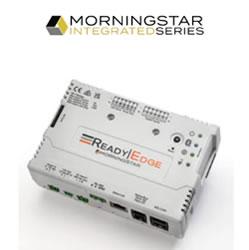Design Considerations for Efficient and Effective Battery Energy Storage Installations
If the world is to turn to more renewable sources of energy, it needs more energy storage. As more and more systems electrify, storing electricity to use when it is needed is a critical process. The International Energy Agency reports that in order to triple global renewable energy capacity by 2030, as is expected, energy storage capacity needs to increase six-times.
Designing effective and efficient energy storage infrastructure involves a careful balance of technical, environmental and human factors. Creating a thoughtful design not only improves the system's reliability but also increases its contribution to a sustainable future. Here are some key trends anyone involved in energy storage infrastructure needs to keep an eye on:
Advances in Liquid Cooling for Batteries
To maintain both performance and safety, batteries must be kept cool. There are a wide range of cooling technologies deployed in energy storage systems depending on the power density of a particular installation. For some parts of systems, including keeping controls and monitoring technology at acceptable operating temperatures, air cooling is a good solution. However, for installations with higher energy density, including most utility applications, liquid cooling is often a better choice.
Liquid cooling works in battery energy storage applications by using a chiller to pump cooled fluid through the system in a closed loop, with precision control adjusting fluid temperature and flow rates to maximize efficiency. Hot or cold liquid is pumped through hoses and manifolds to racks of batteries. Liquid is then pumped through hoses to each individual battery and back to the chiller where it is cooled and recirculated. The entire system is a completely closed loop, so risks of leaks or liquid coming into contact with electrical infrastructure are minimized. However, to reduce the risk of leaks, reliable systems are nonnegotiable.
Liquid cooling is more effective than air cooling at cooling batteries. Not only does it keep surrounding air temperatures cooler, it allows for more effective temperature control and offers a higher range of cooling due to liquid’s improved heat transfer capacity. Using the cooling efficiency of energy storage systems with liquid cooling, battery module manufacturers can use higher energy dense batteries to increase the total power capacity of their installations without extreme increases in the amount of energy spent on cooling and reductions in safety.
Grounding Best Practices Remain Critical
Even as energy systems become more complex, the basics remain essential. All electrical systems also require proper surge protection and grounding. Current always flows through the path of the lowest impedance, and even the most well-designed electrical systems can be at risk from fault currents from lightning, equipment malfunctions, or surges from power sources.
Good grounding and bonding systems must consider soil conditions, seasonal patterns, and other unique site differences. This improves safety for people working with and around electrical equipment while maintaining reliability. Energy storage installations must follow best practices for proper bonding and grounding, considering site locations, soil resistivity levels, and corrosion levels. Based on these factors, different types of connections, such as mechanical, compression, or exothermic, may be required to ensure the grounding and bonding systems work effectively.
Many energy storage installations simply rely on local codes to determine grounding and bonding approaches. This can create problems, as designs do not always follow best practices for site conditions where installation are built. Conducting proper grounding studies up front will pay off in safety and reliability down the line.
Microgrid Integration Key to Adoption
Microgrids have the potential to mitigate or solve many of the problems facing modern electrical infrastructure and are accordingly top of mind for many energy storage application engineers. Whether a company’s primary focus is fleet vehicle electrification, renewable energy, or backup power, many of these technologies will eventually be integrated into a microgrid, so thinking about compatibility and safety is essential.
Energy storage is critical in microgrid systems to decouple the time of energy production from the time of power use. Consequently, energy storage systems can also play a pivotal role in preparing energy systems to manage environmental threats and support people through times when grid power is unavailable. Microgrids can also reduce energy costs by using stored power during times when grid power is particularly expensive.
Many different features can make different energy technologies more useful to microgrids. For instance, modular components simplify replacements and upgrades, minimizing downtime. Scheduled and predictive maintenance plans for cooling and other auxiliary systems is also especially critical for microgrid applications. Additionally, it is important to design a layout of electrical components that facilitates access to key components for routine inspections and repairs.
Power Connections Can Make or Break Installations
Power connections are used to connect battery energy storage systems to the systems they are powering, as well as their source of energy, be it a renewable energy resource or the grid. These connections can create failure points if not done correctly.
In these connections, it is critical to use high-quality lugs and certified tools. Lugs, which are connectors used to terminate and connect electrical cables, must be properly installed to maintain a secure and efficient electrical connection. Certified tools, specifically designed for crimping and securing lugs ensure that the connections are made with the correct pressure and precision, reducing the risk of loose connections, overheating and potential electrical failures. Additionally, there is a growing need for kitted solutions for lugs in order to minimize labor time and on-site human error that can reduce the resilience and reliability of systems.
By adhering to industry standards and using certified tools, installers can significantly enhance the durability and performance of electrical systems, ultimately contributing to a safer and more reliable power infrastructure.
Extreme Weather is Increasing
Natural disasters including hurricanes, severe storms, winter storms, wildfires and heat waves are becoming more frequent and severe, causing widespread power outages across the United States. Between 2000 and 2023, 80% of U.S. power outages were caused by weather events.
Lightning shielding systems are designed to protect structures from a direct strike by providing a continuous path or discharge point for the current to the ground. They typically consist of masts, shield wires and down conductors tied to a grounding system. Lightning arresters (surge arresters) are also used. These do not permit electrical flow under normal conditions but can change properties in response to a strike, becoming conductors rather than insulators to redirect excess electrical energy.
Even with good protection systems in place, energy storage installation designers need to prepare for storm recovery in case energy storage systems are impacted. One way to do this is to use readily available parts that can be delivered quickly in case of emergency. With more and more critical systems relying on energy storage, rapid delivery of parts for repair and maintenance is becoming a bigger factor in choosing suppliers for battery energy storage systems.
Energy storage is an exciting technology with a wide variety of applications in the electrified world. Following these trends will help engineers and installers stay on top of changes in the industry so they can keep building reliable, safe installations.
 Dave Dong is a seasoned professional in the electrical solutions industry. He currently serves as the Director of Vertical Growth for North America at nVent. With a decade of experience at nVent, Dave has been instrumental in steering the company’s Power and Grounding Solutions division toward innovative heights. Holding an Electrical Engineering degree, Dave’s expertise lies in the dynamic fields of Energy Storage and e-mobility. His forward-thinking approach has consistently driven advancements in these areas, contributing to nVent’s reputation as a leader in electrical solutions. Dave’s commitment to excellence and his strategic vision for integrating sustainable energy practices have positioned him as a key player in the industry. His work reflects a deep understanding of electrical engineering principles and a passion for leveraging technology to meet the evolving demands of energy storage and electric mobility
Dave Dong is a seasoned professional in the electrical solutions industry. He currently serves as the Director of Vertical Growth for North America at nVent. With a decade of experience at nVent, Dave has been instrumental in steering the company’s Power and Grounding Solutions division toward innovative heights. Holding an Electrical Engineering degree, Dave’s expertise lies in the dynamic fields of Energy Storage and e-mobility. His forward-thinking approach has consistently driven advancements in these areas, contributing to nVent’s reputation as a leader in electrical solutions. Dave’s commitment to excellence and his strategic vision for integrating sustainable energy practices have positioned him as a key player in the industry. His work reflects a deep understanding of electrical engineering principles and a passion for leveraging technology to meet the evolving demands of energy storage and electric mobility
Comments (0)
This post does not have any comments. Be the first to leave a comment below.
Featured Product

